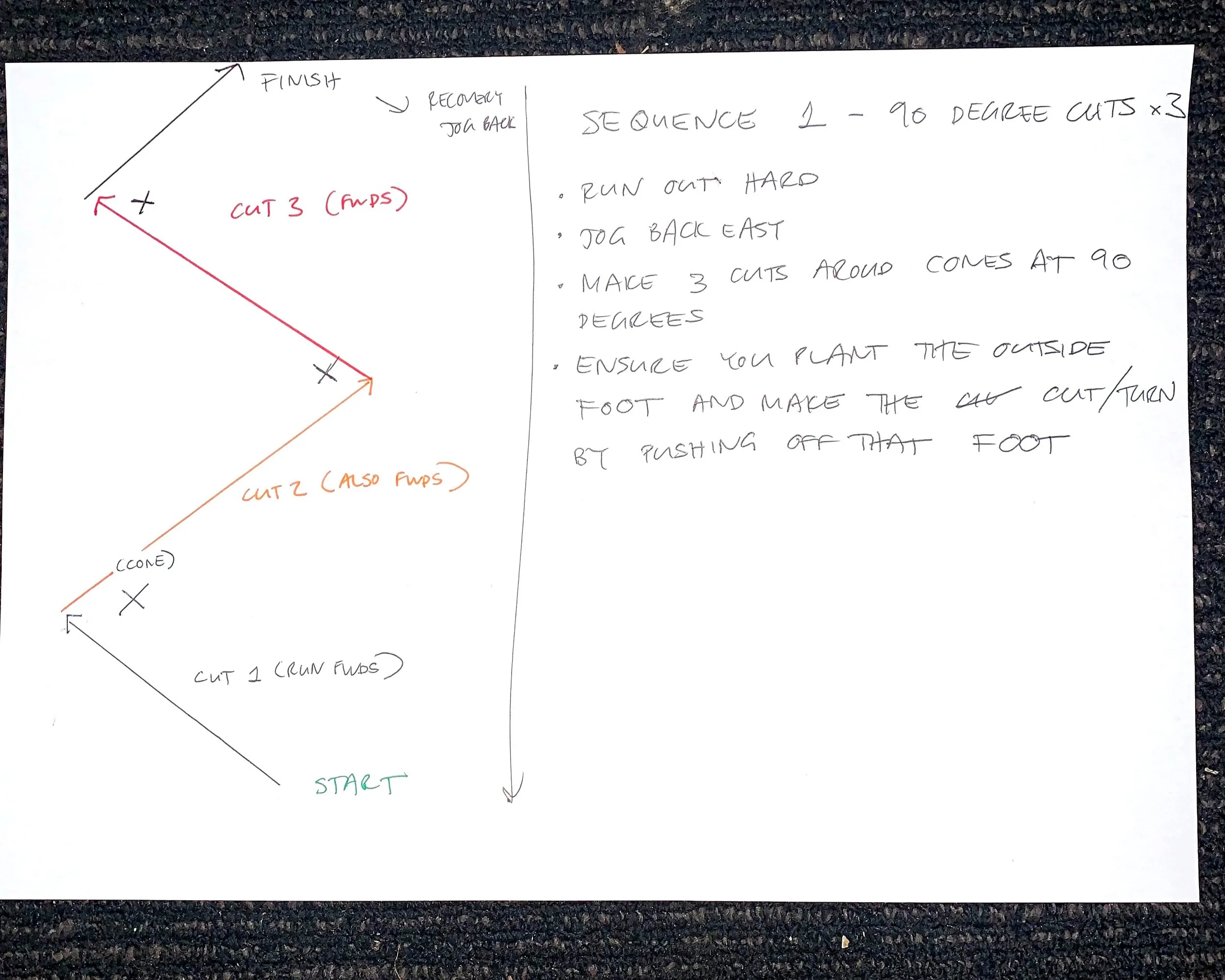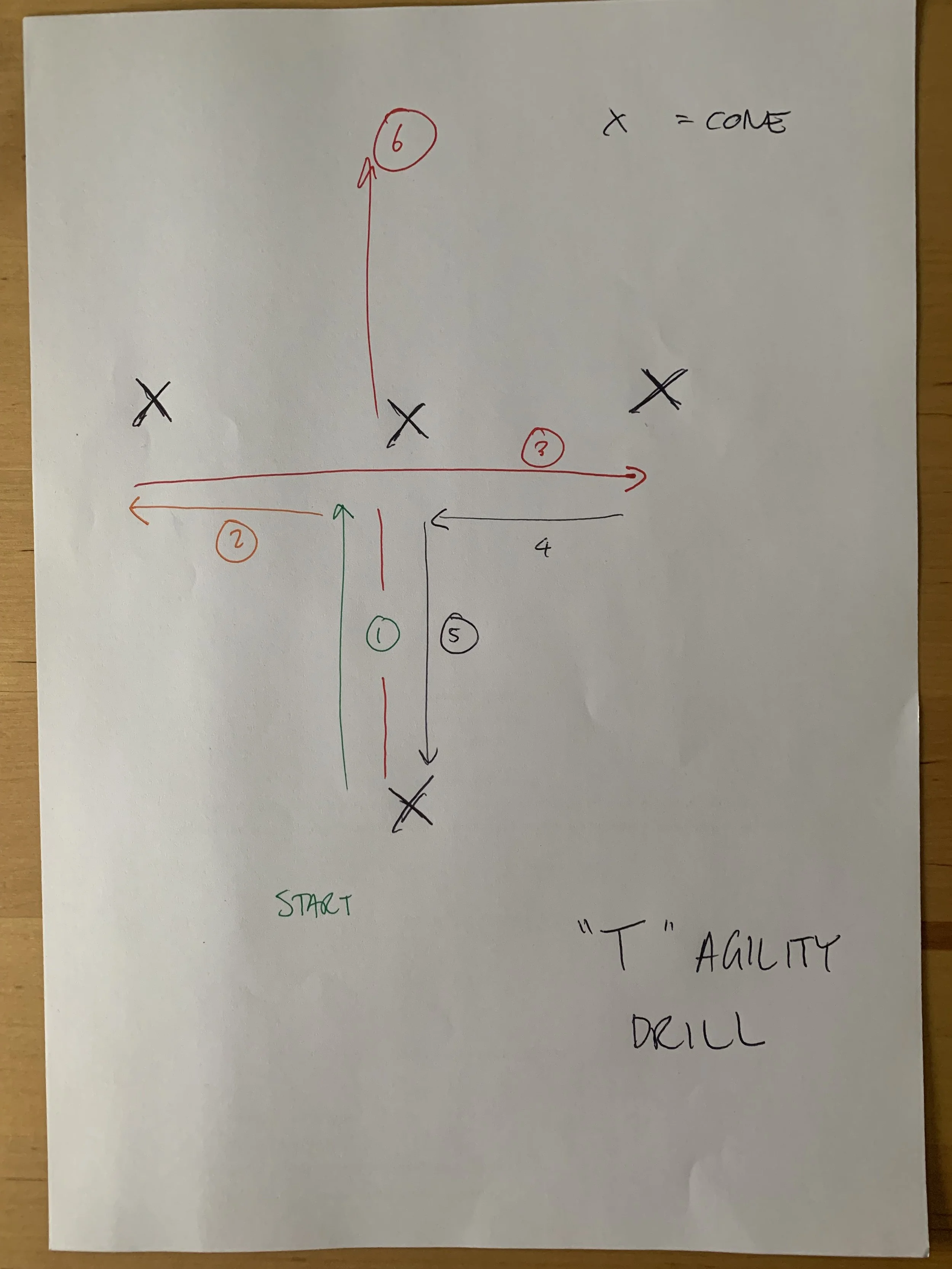MODS-OGM Junior Running Fitness Resources - 2025
This post details running fitness resources that Mods-OGM junior coaches can utilise to work on running speed, endurance and agility for their players.
These session plans are all designed to be delivered in 10-15 minutes at the start or end of the session.
These plans run on a four-weekly cycle:
Week 1: Running game
Week 2: Speed
Week 3: Agility
Week 4: Endurance
The idea is that each session is repeated 3 times on a 4-week cycle (for a total of 12 weeks).
Please scroll below to see the section that is relevant to you, but bear in mind all of the agility content for all ages is contained within the J5/6 section below.
Importantly, when working on the running fitness of players, we can’t expect miracles. It will be counterproductive and potentially injurious to flog the slower, or less fit players during fitness development activities.
If it is challenging but not overwhelming, they are more likely to be willing to engage in this for the long term. If we hit this “sweet spot” where we are applying a manageable amount of stress to the body, it will adapt and improve. Players will find it enjoyable, they’ll see the benefits on the field, and the whole team reaps the rewards.
For any players which are really labouring during fitness activities, I suggest you offer them the chance to take extra breaks. It is fine to skip a rep or two of an activity. It’s also important to do your best to discourage players from racing each other too much (a little bit is fine). Too much racing can undermine their ability to complete the whole session at a good pace.
JUNIOR 5/6
WEEK 1: GAME
“Scarecrow”
Objective: Turn everyone into a scarecrow.
Instructions:
1/ Utilise one quarter of the field (if you wish to use less, then utilise cones to demarcate the altered boundaries).
2/ One player (or a few players) starts as “it”.
3/ The “it” player/s tag other players, and when they do so the tagged player has to stand still with legs and arms out to the side (like a scarecrow).
4/ If a free/untagged player crawls through the legs of a scarecrow, they are released and can return to evading the “it” player/s.
5/ The game ends when the “it” player/s have turned everyone into a scarecrow or the predetermined time interval (according to the coach) has ended
WEEK 2: SPEED
25 yard sprints with a “flying start”
Objective: Develop sprinting speed without the physical stress of acceleration from a stationary position.
Instructions:
1/ Utilise half of the field.
2/ The whole squad does this together. The sprints start on a 90s cycle with the coach timing on their watch or phone (this can be adjusted by coach if needed). Players that are struggling can skip a rep if needed.
3/ Players line up on the baseline.
4/ At go, they build up speed to hit a sprint at the 25 yard line.
5/ They then sprint from the 25 yard line to the centre line.
6/ Players turn around and jog back to the start then rest until 90 seconds has elapsed.
7/ Complete 6-9 reps in 10-15 minutes.
8/ Suggestion: if players need a more difficult option they can;
add distance to the sprint (if the other half of the field is free)
start the sprint earlier (e.g. at the mid way point between the baseline and 25 yard line)
WEEK 3: AGILITY
Coaches can choose 1-3 of these options to build an agility focussed component to the training session.
Option 1: Together Time - Agility
Objective:
Work on fundamental physical capability to express agility (i.e. the physical basics of being agile)
Do this in a group (which adds fun and motivation). That’s why this is called “together time”!
Instructions:
Create a 5-10 exercise circuit with varied work and rest time periods (aka “intervals”). For example - 5 exercises, 30s work, 15s rest.
After the circuit has been completed, a longer rest can be taken, e.g. 60s. So, you make have 5 rounds of 30s work / 15s rest, followed by a 60s longer rest. This whole thing could be repeated 2-3 times.
Example:
30s work / 15s rest x 5. Then 60s off. Repeat once for a total of 2 rounds.
Exercise 1: Bounding
Exercise 2: Stationary Single Leg Hopping - Left Leg
Exercise 3: As above but right leg
Exercise 4: Fast feet
Exercise 5: Forwards and backwards two legged jumps
Exercise Ideas:
Option 2: Long Running With Direction Changes (refer to images)
Description: Running over a longer distance (e.g. half to full field) with agility challenges that are similar to game play - like making a long lead with a moderate difficulty change of direction.
Objective:
Develop match specific running skills
Instructions:
Select one or more of these sequences that suits your time constraints (err on the side of fewer exercises)
Feel free to create your own
Sequence 1 - 90 degree cuts x 3
Sequence 2 - Forwards and backwards on diagonal
Sequence 3 - Forwards & sideways (left, right)
Option 3: Short Running With Direction Changes
Description: Shorter distance running (e.g. over 5-10 metres) practising agility challenges similar to game play - like defending / channeling / short & sharp direction changes.
Short Distance, Forwards and Backwards Running
Instruction:
1/ Players are lined up on base line.
2/ On the whistle, players run forwards and backwards (fast) to and from the 25 yard line.
3/ Take 10-15s rest.
4/ Repeat 10 times.
T Agility
Instruction:
1/ Using hockey dots or cones, mark out the perimeter of a “T”. The base of the T is on the base line. Ideally, you can have about 5 of these.
2/ Follow the sequence outlined in the image below.
3/ Once the player has gone thorough the T sequence, they run to the 25 yard line, turn right, and run hard following the perimeter back to the starting point.
4/ Rest enough that the “T” (and run) can be done with intensity. But not too much rest. We want the system to be challenged but not overwhelmed.
WEEK 4: ENDURANCE
Pick one of the following options.
Fartlek Intervals (Fartlek means “speed play” and it refers to alternating between easy and hard running)
1/ Use the perimeter of one quarter of the field
2/ The coach uses his/her whistle to indicate when a hard or easy interval finishes. Coach will also need their own watch or phone to time intervals.
3/ Use one of these age appropriate “recipes” for J5/6
5s 10/10 effort followed by a 20s very easy jog (not walk). Perform this cycle 10 times then rest one minute. Repeat once for a total of 2 rounds.
10s 9/10 effort followed by a 20s jog (3-4/10) effort. Perform this cycle 5 times then rest one minute. Repeat once for a total of 2 rounds.
20s 8/10 effort followed by a 20s steady run (5/10) effort. Perform this cycle 5 times then rest one minute. Repeat once for a total of 2 rounds.
30s 7/10 effort followed by a 30s steady run (5/10) effort. Perform this cycle 3 times then rest two minutes. Repeat once for a total of 2 rounds.
Straight Line Intervals (These intervals are running at different moderate/hard intensities with passive, stationary rest periods)
1/ Use half the hockey field. The course is simply out from the baseline to a certain marker (maximum 50 yard/centre line) and back again. A few different markers can be offered to accommodate different levels of speed and fitness. I suggest you present three options. The hardest option is what is written under point three below. Coaches can use their judgement to determine how much distance to take off in the other options. For example, if the players will be running out to the 50 yard line and back, you can offer one option at 40 yards (for a total of 80 yards out/back) and another at 35 yards (for a total of 70 yards out/back).
2/ Coach will use their watch and/or phone to time the intervals and whistle to indicate the start and finish.
3/ Use one of these age appropriate “recipes” for J5/6
25 yard line, out and back. 30s intervals. 6 reps then 60s rest. Repeat once for a total of two full rounds.
50 yard line, out and back. 60s intervals. 4 reps then 90s rest. Repeat once for a total of two full rounds.
JUNIOR 7/8
WEEK 1: GAME
“No-Tackling British Bulldogs”
Setup:
Choose either half the field or a quarter of the field
Using cones, narrow the width of the area (based on your judgement). We want it to be challenging (but not too challenging for bulldogs to tag runners).
The safe zones are on the outside of the quarter (25 yard line) or half (centre line).
One or more players start as Bulldogs in the middle. The number is up to the coach.
The remaining players stand in one safe zone.
Objective:
Runners must get from one safe zone to the other without being caught by a Bulldog.
Bulldogs must try to stop runners without tackling.
How Bulldogs Stop Runners (No Tackling Versions):
Tagging Version: Bulldogs must tag runners with their hands. Once tagged, the runner becomes a Bulldog.
Winning the Game:
The last runner remaining is the winner.
The game resets with a new starting Bulldog.
WEEK 2: SPEED
37.5 yard sprints with a flying start
Objective: Develop sprinting speed without the physical stress of acceleration from a stationary position.
Instructions:
1/ Utilise half of the field.
2/ The whole squad does this together. The sprints start on a 90s cycle with the coach timing on their watch or phone (this can be adjusted by coach if needed). Players that are struggling can skip a rep if needed.
3/ Players line up on the baseline.
4/ At go, they build up speed to hit a sprint at the mid position between the baseline and 25 yard line (or at the 16 yard line).
5/ They then sprint to the centre line.
6/ Players turn around and jog back to the start then rest until 90 seconds has elapsed.
7/ Complete 6-9 reps in 10-15 minutes.
8/ Suggestion: if players need a more difficult option they can;
add distance to the sprint (if the other half of the field is free)
start the sprint earlier (e.g. eliminate the flying start and sprint from a dead start)
WEEK 3: AGILITY
Refer to J5/6 agility content above.
WEEK 4: ENDURANCE
Pick one of the following options.
Fartlek Intervals (Fartlek means “speed play” and it refers to alternating between easy and hard running)
1/ Use the perimeter of one quarter of the field
2/ The coach uses his/her whistle to indicate when a hard or easy interval finishes. Coach will also need their own watch or phone to time intervals.
3/ Use one of these age appropriate “recipes” for J7/8
5s 10/10 effort followed by a 20s very easy jog (not walk). Perform this cycle 12 times then rest one minute. Repeat once for a total of 2 rounds.
15s 9/10 effort followed by a 25s jog (3-4/10) effort. Perform this cycle 6 times then rest one minute. Repeat once for a total of 2 rounds.
25s 8/10 effort followed by a 25s steady run (5/10) effort. Perform this cycle 6 times then rest one minute. Repeat once for a total of 2 rounds.
40s 7/10 effort followed by a 30s steady run (5/10) effort. Perform this cycle 4 times then rest two minutes. Repeat once for a total of 2 rounds.
Straight Line Intervals (These intervals are running at different moderate/hard intensities with passive, stationary rest periods)
1/ Use half the hockey field. The course is simply out from the baseline to a certain marker (maximum 50 yard/centre line) and back again. A few different markers can be offered to accommodate different levels of speed and fitness. I suggest you present three options. The hardest option is what is written under point three below. Coaches can use their judgement to determine how much distance to take off in the other options. For example, if the players will be running out to the 50 yard line and back, you can offer one option at 40 yards (for a total of 80 yards out/back) and another at 35 yards (for a total of 70 yards out/back).
2/ Coach will use their watch and/or phone to time the intervals and whistle to indicate the start and finish.
3/ Use one of these age appropriate “recipes” for J5/6
25 yard line, out and back. 30s intervals. 8 reps then 60s rest. Repeat once for a total of two full rounds.
50 yard line, out and back. 60s intervals. 6 reps then 90s rest. Repeat once for a total of two full rounds.
JUNIOR 9/10
WEEK 1: GAME
“No-Tackling British Bulldogs”
Setup:
Choose either half the field or a quarter of the field
Using cones, narrow the width of the area (based on your judgement). We want it to be challenging (but not too challenging for bulldogs to tag runners).
The safe zones are on the outside of the quarter (25 yard line) or half (centre line).
One or more players start as Bulldogs in the middle. The number is up to the coach.
The remaining players stand in one safe zone.
Objective:
Runners must get from one safe zone to the other without being caught by a Bulldog.
Bulldogs must try to stop runners without tackling.
How Bulldogs Stop Runners (No Tackling Versions):
Tagging Version: Bulldogs must tag runners with their hands. Once tagged, the runner becomes a Bulldog.
Winning the Game:
The last runner remaining is the winner.
The game resets with a new starting Bulldog.
WEEK 2: SPEED
37.5 yard sprints with a flying start
Objective: Develop sprinting speed without the physical stress of acceleration from a stationary position.
Instructions:
1/ Utilise half of the field.
2/ The whole squad does this together. The sprints start on a 90s cycle with the coach timing on their watch or phone (this can be adjusted by coach if needed). Players that are struggling can skip a rep if needed.
3/ Players line up on the baseline.
4/ At go, they build up speed to hit a sprint at the mid position between the baseline and 25 yard line (or at the 16 yard line).
5/ They then sprint to the centre line.
6/ Players turn around and jog back to the start then rest until 90 seconds has elapsed.
7/ Complete 6-9 reps in 10-15 minutes.
8/ Suggestion: if players need a more difficult option they can;
add distance to the sprint (if the other half of the field is free)
start the sprint earlier (e.g. eliminate the flying start and sprint from a dead start)
WEEK 3: AGILITY
Refer to J5/6 agility content above.
WEEK 4: ENDURANCE
Pick one of the following options.
Fartlek Intervals (Fartlek means “speed play” and it refers to alternating between easy and hard running)
1/ Use the perimeter of one quarter of the field
2/ The coach uses his/her whistle to indicate when a hard or easy interval finishes. Coach will also need their own watch or phone to time intervals.
3/ Use one of these age appropriate “recipes” for J7/8
5s 10/10 effort followed by a 20s very easy jog (not walk). Perform this cycle 12 times then rest one minute. Repeat once for a total of 2 rounds.
15s 9/10 effort followed by a 25s jog (3-4/10) effort. Perform this cycle 6 times then rest one minute. Repeat once for a total of 2 rounds.
25s 8/10 effort followed by a 25s steady run (5/10) effort. Perform this cycle 7 times then rest one minute. Repeat once for a total of 2 rounds.
40s 7/10 effort followed by a 30s steady run (5/10) effort. Perform this cycle 5 times then rest two minutes. Repeat once for a total of 2 rounds.
Straight Line Intervals (These intervals are running at different moderate/hard intensities with passive, stationary rest periods)
1/ Use half the hockey field. The course is simply out from the baseline to a certain marker (maximum 50 yard/centre line) and back again. A few different markers can be offered to accommodate different levels of speed and fitness. I suggest you present three options. The hardest option is what is written under point three below. Coaches can use their judgement to determine how much distance to take off in the other options. For example, if the players will be running out to the 50 yard line and back, you can offer one option at 40 yards (for a total of 80 yards out/back) and another at 35 yards (for a total of 70 yards out/back).
2/ Coach will use their watch and/or phone to time the intervals and whistle to indicate the start and finish.
3/ Use one of these age appropriate “recipes” for J5/6
25 yard line, out and back. 30s intervals. 9 reps then 60s rest. Repeat once for a total of two full rounds.
50 yard line, out and back. 60s intervals. 7 reps then 90s rest. Repeat once for a total of two full rounds.




